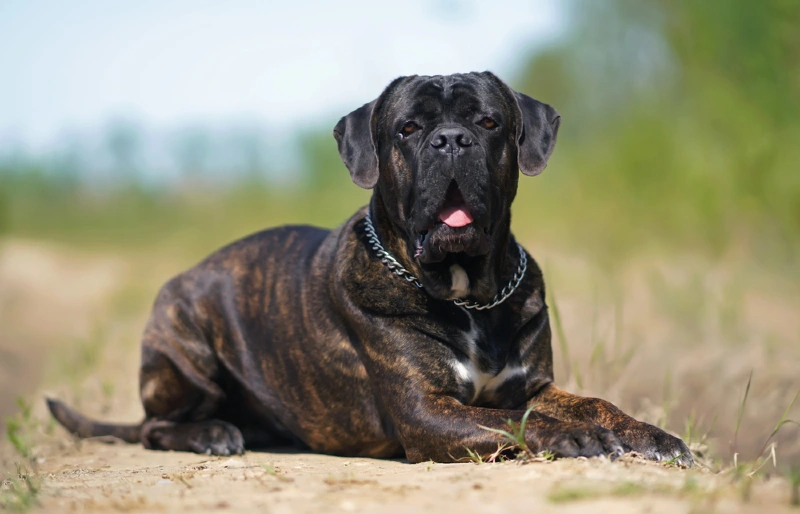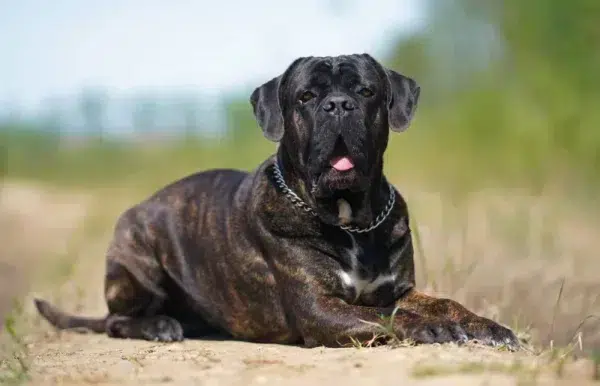One of the most popular dogs in the U.S.A. is the Cane Corso. These dogs are muscular giants with hearts of gold that are often misunderstood due to their intimidating appearance. Their bulky bodies hide the intelligence, loyalty, and affectionate natures that these dogs are loved for.
To help clear the air — and to show you why the Cane Corso is a total sweetheart despite their appearance — here are 16 fascinating facts about this breed.
The 16 Fascinating Cane Corso Facts
1. They Are an Ancient Breed
The original ancestors of the Cane Corso were first developed by the Molossi, a group of tribes in ancient Greece. “Molossus dogs” or “molosers” were giant1, big-boned Mastiff-type animals that were bred to be guardians. They were the building blocks for the Cane Corso dogs that we adore today.
Mollosers were taken back to Italy by the ancient Romans who occupied the Greek islands when the Roman Empire was at its strongest. The Greek dogs were then bred with Italian breeds to become warriors that could carry buckets of flaming oil through enemy lines.
Since then, the breed has become smaller, leaner, and more graceful than the lumbering giants that the Romans preferred as war dogs.
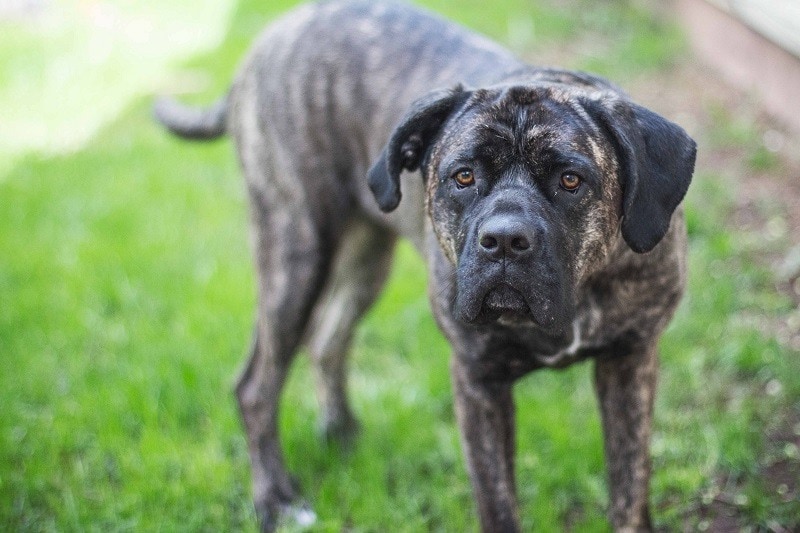
2. Their Name Is Latin for “Bodyguard Dog”
As you might expect from a breed that originated in Ancient Rome, the name Cane Corso — pronounced “KAH-neh KOR-soh” — is Latin. Although some breed lovers believe that the name means “coursing dog,” referring to the pursuit of prey using sight rather than scent, the name actually translates to “bodyguard dog,” “guard of the estate,” or “robust dog.”
When you consider that these dogs were originally bred to fight alongside the Romans in battle before they were used for farm work, the name suits their fierce appearance and loyalty.
3. They Almost Went Extinct
Despite how long the Cane Corso has been around, the breed was almost wiped out entirely during the 20th century. Although they were first bred as warriors who fought battles alongside soldiers, the breed became a common sight on farms and during boar hunts when the Western Empire was dissolved. While they no longer fought in battles, they excelled at their new jobs.
Unfortunately for the Cane Corso, during the 20th century, Italy saw a huge number of mechanized farming innovations, invasions, and economic and political upheaval, along with both World Wars. All of this reduced the breed’s population substantially and almost eradicated them.
It wasn’t until the 1970s that the Cane Corso was revived due to the efforts of Dr. Paolo Breber and a group of dedicated breed fanciers. The Society Amorati Cane Corso — or the Society of Cane Corso Lovers — was officially established in 1983.
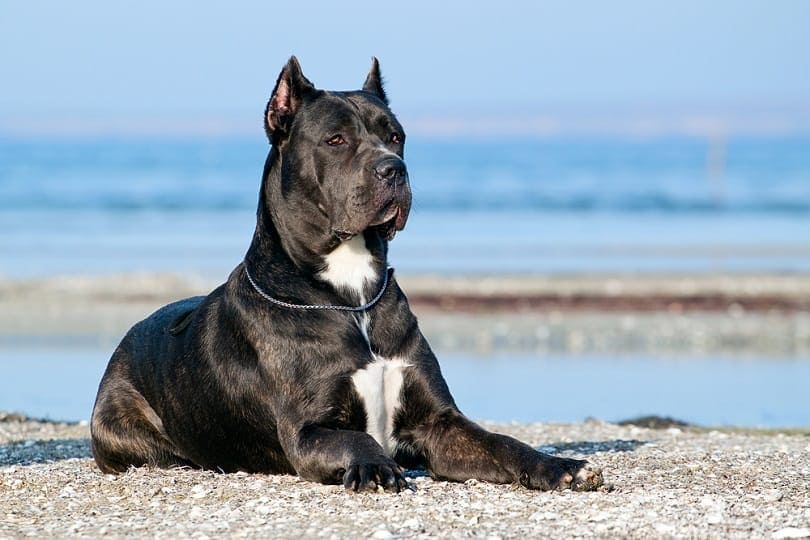
4. The Neapolitan Mastiff Is a Close Relative
Despite their greater size and more wrinkled skin, the Neapolitan Mastiff has similar roots to the Cane Corso2. They were bred in ancient Rome from the same molossus dogs that started the Cane Corso, making the two breeds close cousins.
Neapolitan Mastiffs also had a similar purpose, with many of their ancestors being used to accompany the Roman legions during wars and in the Colosseum. Their fierce appearance and size were developed to strike fear in the enemies of Rome and still serve Neapolitan Mastiffs — and Cane Corso dogs — well today as guardian dogs.
5. The Plural Is Cani Corsi
Many people assume that the name, “Cane Corso,” is how you refer to individual members of the breed, as well as larger groups. Unlike other dog breeds, where you just add an “s” to the end (German Shepherds, Labrador Retrievers, etc.), the plural form of “Cane Corso” is “Cani Corsi,” not “Cane Corsos,” since the name originates from the Latin.
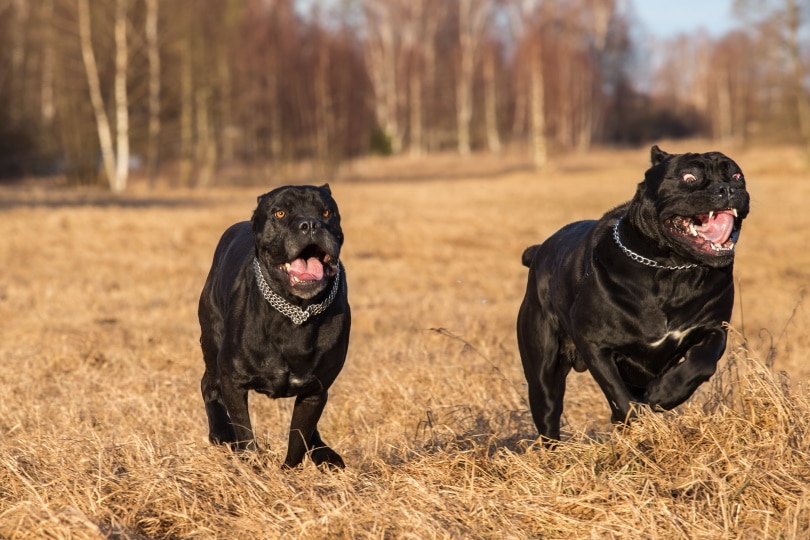
6. They Are Fiercely Loyal
Their fierce appearance isn’t the only trait that the Romans favored in the Cane Corso. The natural protectiveness of the breed gave them a warrior-like disposition on the battlefield and a strong loyalty to the soldiers and later, the livestock that they guarded.
This devout loyalty makes them great watchdogs for the home and for families who are experienced dog owners. Their loyalty also serves another purpose. They are highly attuned to their people and are incredibly sensitive to whatever you might be feeling.
To develop this loyalty, you should train this dog yourself rather than send them away to an obedience school. Building trust between you and your Cane Corso will help strengthen the bond between you.
7. Proper Socialization Is Essential
Standing 28 inches tall and often weighing more than 100 pounds, the Cane Corso is a big dog. Their fierce appearance and natural guardian instincts serve them well as a watchdog, but they need to be taught how to act around other animals and people from a young age.
Dedicating the time to teaching your Cane Corso puppy to respect other animals and people won’t diminish their fierce protective streak, but it will teach them how to behave when they meet someone new.
Since the breed is loyal and highly protective of those whom they consider family, socialization will help them tolerate visitors.
8. They Are Talkative
Along with being incredibly family-oriented, the Cane Corso is quite talkative. Some individuals are quieter than others, depending on their personality, but many of them will vocalize their wants and talk with you in their own doggy language.
While some members of the breed will bark at everything, others will express themselves with howls, snuffles, and snorts. Many will use a mix of singing and howling to create a “roo-roo” sound that entertains everyone who hears it.
9. They Once Fought Lions
The Romans were well known for the sports that they hosted in the Colosseum. Among the human gladiators who fought in the ring, there were also animal contestants. Fighters would face down fellow humans or occasionally, wild animals. Bears, bulls, and lions were often frequent adversaries.
The warrior-like Cane Corso also found a place in the arena. Along with fighting gladiators, they would commonly fight lions and other wild animals brought into the ring3.
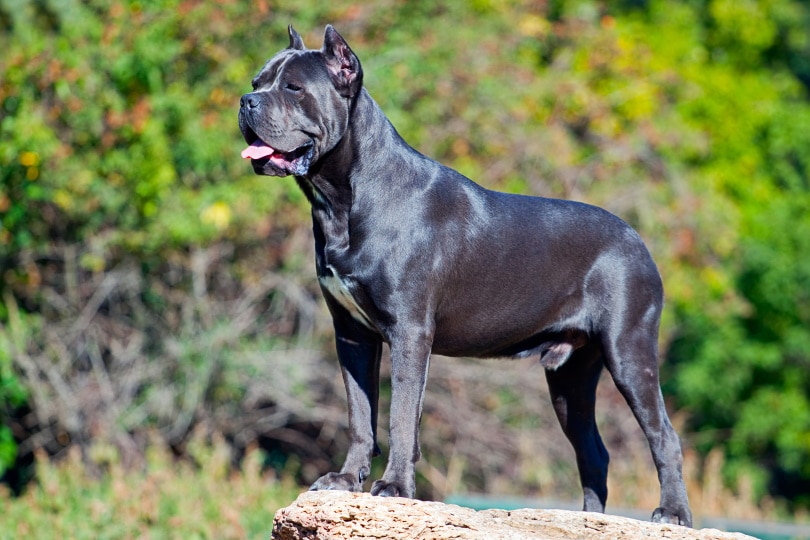
10. Cani Corsi Are Highly Intelligent
As you’d expect from a working dog breed, the Cane Corso is an intelligent guardian dog. Their intelligence combined with their eagerness to please and loyalty to their family make them keen learners. They’re also challenging dogs for inexperienced dog owners.
If you have a Cane Corso puppy, you need to start their training as early as possible to ensure that they grow to be a Good Canine Citizen. You need to use firm, consistent commands and have a no-nonsense presence that will teach your puppy that you’re the one in charge. Keep training sessions short and fun to engage your dog and prevent their stubborn streak from showing itself.
Due to their intelligence, the Cane Corso also do best if they have a job of some kind. They like to be challenged with new tricks as much as they enjoy cuddling with you.
11. The Cane Corso’s Lifespan Depends on Its Coat Color
It’s a known fact that the Cane Corso doesn’t live as long as most other large breeds. This breed’s average lifespan is between 9 and 12 years, but most Cane Corsi tend to pass away after 10 years.
Believe it or not, the coat color of your Cane Corso can influence how long it will live. Recent studies show a clear correlation between the color of your Cane Corso’s fur and its lifespan, as Brindle Cane Corsi tend to live up to 10.13 years.
On the other hand, Gray Brindle Cane Corsi only lived 9.84 years, while Black Brindle Cane Corsi lived approximately 10.30 years. Still, it’s worth noting that further studies are required to back up these numbers.

12. Cane Corsi Are a Formidable Breed
Cane Corsi are 27 inches tall and weigh over 100 pounds on average. They’re known for their large heads and mouths, making it clear that their bodies were originally bred for work. That also means they’re strong enough to attack an average adult when needed, which can be scary for potential pet owners.
Before you get yourself a Cane Corso, it’s worth noting that you may need to pay more for home insurance. These dogs can be incredibly loving and intelligent, but only with the right training. Without the proper training and attention, Cane Corsi can turn destructive and vicious, even attacking strangers when they feel threatened.
Don’t let their bad reputation scare you if you’re willing to train your Cane Corso with love and care. Training them correctly will allow you to turn them into a loving and intelligent part of your family.
13. Cane Corsi Originated in Italy
Cane Corsi originated in Italy, which is unsurprising considering their name’s pronunciation. However, their ancestors were actually Greek and brought over to Italy by the Romans after they conquered the country.

14. The Cane Corso Was a Muse for Italian Art
Aside from working as farm dogs in Italy, Cane Corsi were also once muses for famous Italian artists. That includes Bartolomeo Pinelli and Andrea Mantegna, as these dogs were featured in many of their paintings.
Sculptors were also inspired by these dogs, studying their athletic form as a basis for their artwork. Considering both Cane Corsi and many Renaissance painters originated in Italy, it’s no surprise that these majestic dogs inspired many artistic pieces during that era.
15. Cane Corsi Thrive on Early Training
Cane Corsi can be incredibly intelligent, protective, loyal, and social, but only if trained correctly. While feisty behavior may look adorable on Chihuahua, Cane Corsi are too big for pet owners to allow aggressive behavior.
When left untrained, Cane Corsi can become destructive and dangerous. It’s crucial to begin socializing and correcting your Cane Corso when it’s still a puppy, as it will allow them to grow in a non-violent environment.
Luckily, training a Corso isn’t too difficult as they love to work and learn for their owners.
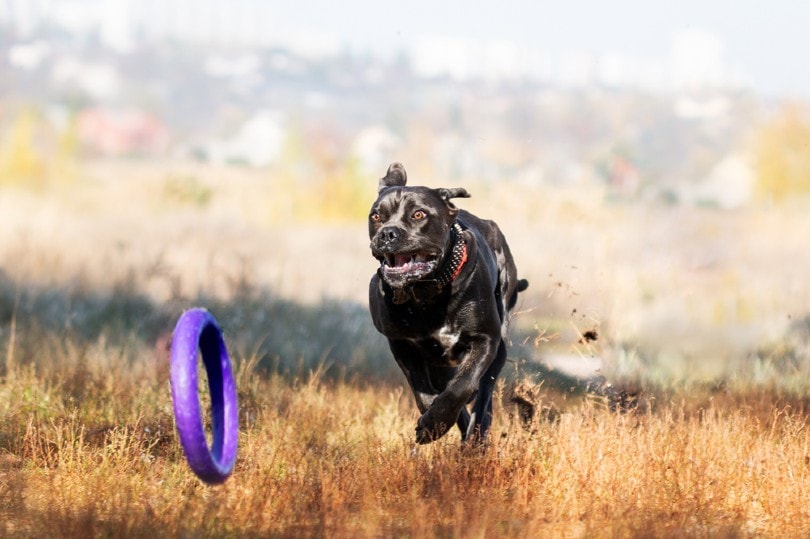
16. You’re Probably Pronouncing Cane Corso Wrong
It may make sense to pronounce Cane Corso like “Kayn Cor-So,” similar to the walking aid. However, since the dog originated in Italy, the correct way to pronounce its name is “Kah-Nay Cor-So.”
Is a Cane Corso a Good Family Dog?
Appearances can be deceiving: These dogs adore their family members. When they’re properly socialized from a young age with children, pets, and other people, they’re calm and indifferent to strangers and affectionate with their loved ones.
You can help ensure that your Cane Corso and children get along by teaching both your puppy and your kids how to safely interact with each other. Children must also be taught to respect dogs and approach them calmly.
Are Cane Corso Dogs Aggressive?
Despite their intimidating appearance, Cane Corso dogs aren’t aggressive. They can be stubborn and willful — particularly if they believe that they’re in charge — and are naturally protective, but this instinct to keep their family safe doesn’t translate into aggression. Well-trained members of the breed often believe themselves to be lap dogs despite their size and are eager to please their people.
However, their appearance often works against them. Like many other intimidating-looking dogs, the Cane Corso is highly desired by owners who want a fierce-looking animal. This rarely results in a well-trained dog and often leads to an animal that walks all over them and scares people outside of the family.
Unfortunately, it’s these dogs whose behavior is most noted and results in their bad reputation. A well-trained Cane Corso is indifferent to dogs and people outside of their family while being a loving companion to their family members.
Final Thoughts
The Cane Corso is a prime example of why you shouldn’t judge a book by its cover — or a dog by their appearance. These intimidating giants adore their family members, are fiercely loyal, and are eager to please. Originally bred as warriors in ancient Rome for both the battlefield and the arena, their purpose slowly shifted to work as guardian animals for livestock and other farmwork.
They’re a favorite breed in the U.S.A., and we hope that these fascinating facts have shown you why!
Related Read:
- Does a Cane Corso Shed a Lot? The Interesting Answer
- Do Cane Corsos Like Water and Swimming? What You Need To Know
Featured Image Credit: Eudyptula, Shutterstock
Contents
- The 16 Fascinating Cane Corso Facts
- 1. They Are an Ancient Breed
- 2. Their Name Is Latin for “Bodyguard Dog”
- 3. They Almost Went Extinct
- 4. The Neapolitan Mastiff Is a Close Relative
- 5. The Plural Is Cani Corsi
- 6. They Are Fiercely Loyal
- 7. Proper Socialization Is Essential
- 8. They Are Talkative
- 9. They Once Fought Lions
- 10. Cani Corsi Are Highly Intelligent
- 11. The Cane Corso’s Lifespan Depends on Its Coat Color
- 12. Cane Corsi Are a Formidable Breed
- 13. Cane Corsi Originated in Italy
- 14. The Cane Corso Was a Muse for Italian Art
- 15. Cane Corsi Thrive on Early Training
- 16. You’re Probably Pronouncing Cane Corso Wrong
- Is a Cane Corso a Good Family Dog?
- Are Cane Corso Dogs Aggressive?
- Final Thoughts

